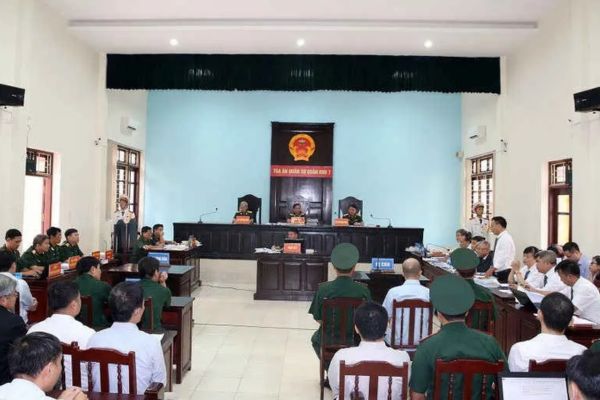Circular 03/2023/TT-TANDTC guiding the subjects under the jurisdiction of the Military Court?
Circular 03/2023/TT-TANDTC Guiding the Jurisdiction of the Military Court
Currently, two subjects under the jurisdiction of the military court are stipulated in clause 1, Article 272 of the 2015 Criminal Procedure Code and specifically guided in Article 3 of Circular 03/2023/TT-TANDTC as follows:
Subject 1
The accused is an on-duty military personnel, official, defense worker, defense public employee, reserve military personnel during training or combat readiness inspection; militia, self-defense forces during training or coordination with the People’s Army in combat or combat service; citizens mobilized, summoned, or contracted to serve in the People's Army. These subjects are specifically guided as follows:
- “On-duty military personnel” includes officers, professional soldiers, non-commissioned officers, and soldiers as stipulated in the Law on Officers of the Vietnam People's Army, Law on Professional Soldiers, Defense Workers and Public Employees, and 2015 Military Service Law;- “Defense officials” are Vietnamese citizens recruited into positions, titles corresponding to job positions in agencies, units under the People’s Army that are not officers, professional soldiers, workers, or defense public employees;- “Defense workers and public employees” include those stipulated in clause 2, Article 2 of Law on Professional Soldiers, Defense Workers and Public Employees 2015;- Reserve military personnel during training or combat readiness inspection as stipulated in 2019 Law on Mobilization of Reserve Forces;- Militia, self-defense forces during training or coordination with the People’s Army in combat or combat service as stipulated in 2019 Law on Militia and Self-Defense Forces;- Citizens mobilized, summoned to serve in the Army or implement contractual labor policies in Army units or enterprises.
Subject 2
The accused not falling under Subject 1 but related to military secrets or causing damage to the life, health, honor, dignity of on-duty military personnel, officials, defense workers, defense public employees, reserve military personnel during training or combat readiness inspection, or causing damage to the property, honor, prestige of the People’s Army, or committing crimes in military camps or military areas managed and protected by the People’s Army. The criminal acts related to military secrets or causing damage to the Army or committing crimes in military camps or military areas managed and protected by the People’s Army are identified as follows:
- Military secrets include the secrets of the Army, defense security, state secrets in the defense field stipulated in the documents of competent state agencies, and party organizations;- Causing damage to the Army includes damage to the life, health, honor, dignity of on-duty military personnel, officials, defense workers, defense public employees, reserve military personnel during training or combat readiness inspection, or causing damage to the property, honor, prestige of the Army;- Committing crimes in military camps or military areas managed and protected by the People’s Army.

Circular 03/2023/TT-TANDTC guiding the jurisdiction of the Military Court. (Image from the Internet)
How is damage to the honor and prestige of the People’s Army determined according to Circular 03/2023/TT-TANDTC?
Based on the provisions of clause 4, Article 2 of Circular 03/2023/TT-TANDTC, "Damage to the honor and prestige of the People’s Army" is damage that seriously affects the image, name, history, tradition, activities of the Army, or severely reduces the public’s trust and confidence in the Army (e.g., using military uniform, documents, tools, devices of the Army to commit crimes; manufacturing fake military uniforms, tools, devices of the Army; forging seals, documents of the Army; using fake seals, documents of the Army; exploiting images of units, military personnel, devices of the Army to commit crimes; editing and misrepresenting images, sounds, disseminating false information about the activities of Army units causing negative public opinion).
What is the current structure of the Military Court system?
Article 50 of the 2014 Law on Organization of the People’s Courts stipulates the structure of the Military Court system as follows:
- The Central Military Court;- Military Regional Courts and their equivalents;- Regional Military Courts.
The organization of each Military Court is as follows:
The Central Military Court
Based on clause 2, Article 51 of the 2014 Law on Organization of the People’s Courts, the organizational structure of the Central Military Court includes:
- The Judicial Committee of the Central Military Court;- The Appellate Court of the Central Military Court;- The assisting apparatus.
The Central Military Court has a Chief Justice, Deputy Chief Justices, Chiefs of Courts, Deputy Chiefs of Courts, Judges, Court Examiners, Court Clerks, officials, and employees.
The Chief Justice of the Supreme People's Court decides on the establishment and stipulates the tasks and powers of the assisting apparatus in the Central Military Court after consulting with the Minister of National Defense.
Military Regional Courts
Article 55 of the 2014 Law on Organization of the People’s Courts stipulates the organizational structure of Military Regional Courts and their equivalents as follows:
- The structure and organization of Military Regional Courts and their equivalents include:+ The Judicial Committee;+ The assisting apparatus.
Military Regional Courts and their equivalents have a Chief Justice, Deputy Chief Justices, Judges, Court Examiners, Court Clerks, other officials, and employees.
The Chief Justice of the Supreme People’s Court decides on the establishment and stipulates the tasks and powers of the assisting apparatus in Military Regional Courts and their equivalents after consulting with the Minister of National Defense.
LawNet
